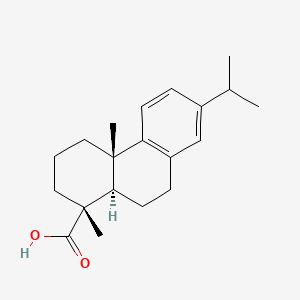
|
Dehydroabietic acid |
Dehydroabietic acid is a lipid of Prenol Lipids (PR) class. Dehydroabietic acid is associated with abnormalities such as Plague. The involved functions are known as RNA Interference and enzyme activity. Dehydroabietic acid often locates in Clone, Entire nervous system, Membrane and Cellular Membrane. |
311 |
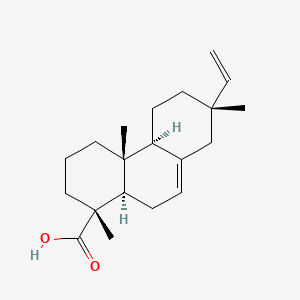
|
isopimaric acid |
Isopimaric acid is a lipid of Prenol Lipids (PR) class. Isopimaric acid is associated with abnormalities such as Dehydration. The involved functions are known as Noise, Increased Sensitivy, nuclear mRNA cis splicing, via spliceosome, Diastasis and spore germination. Isopimaric acid often locates in Protoplasm, Body tissue, Muscle and Microsomes. The associated genes with isopimaric acid are KCNMA1 gene and iberiotoxin. |
55 |
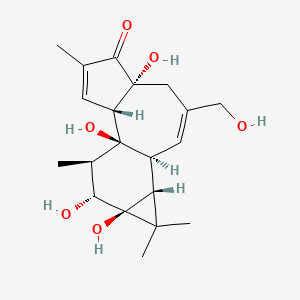
|
Phorbol |
Phorbol is a lipid of Prenol Lipids (PR) class. Phorbol is associated with abnormalities such as furuncle, Infection, endothelial dysfunction, Morphologically altered structure and Acute erythroleukemia. The involved functions are known as Tyrosine Phosphorylation, Metabolic Inhibition, Transcription, Genetic, Protein Biosynthesis and Signal. Phorbol often locates in Tissue membrane, Membrane, Cell surface, soluble and Cytoplasmic Domain. The associated genes with Phorbol are STAT3 gene, JAK2 gene, JUN gene, PROC gene and MAPK8 gene. The related lipids are Lipopolysaccharides, Phosphatidylserines, Liposomes, Fatty Acids and Octanols. |
2082 |

|
phorbol 13-acetate 12-myristate |
Phorbol 13-acetate 12-myristate is a lipid of Prenol Lipids (PR) class. The involved functions are known as DNA Fragmentation, Phosphorylation and Irritation. Phorbol 13-acetate 12-myristate often locates in low-density lipoprotein particle. The associated genes with phorbol 13-acetate 12-myristate are FPR1 gene and ABCB1 gene. |
40921 |

|
Sphingosine 1-phosphate |
Sphingosine 1-phosphate is a lipid of Sphingolipids (SP) class. Sphingosine 1-phosphate is associated with abnormalities such as Infection, Painful Bladder Syndrome, Atherosclerosis, Hyperglycemia and Rheumatoid Arthritis. The involved functions are known as Phosphorylation, Regulation, enzyme activity, Energy Absorption and Vascular Permeability. Sphingosine 1-phosphate often locates in Endothelium, Tissue membrane, Vascular System, Protoplasm and Microfilaments. The associated genes with Sphingosine 1-phosphate are MBTPS1 gene, FBXL15 gene, TEK gene, NTRK1 gene and Gene Family. The related lipids are Promega, Lipopolysaccharides, lysophosphatidic acid, Lysophosphatidylcholines and Lysophospholipids. The related experimental models are Knock-out, Mouse Model, Transgenic Model, Disease model and Experimental Autoimmune Encephalomyelitis. |
2005 |
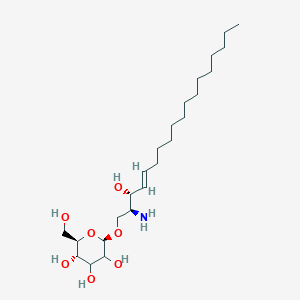
|
Glucosyl sphingosine |
Glucosyl sphingosine is a lipid of Sphingolipids (SP) class. Glucosyl sphingosine is associated with abnormalities such as Sphingolipidoses, Globoid cell leukodystrophy, Sandhoff Disease, Tay-Sachs Disease and Fabry Disease. The involved functions are known as Apoptosis, Acetylation, Infiltration, kinase activity and energy pathways. Glucosyl sphingosine often locates in Lysosomal and Protoplasm. The associated genes with Glucosyl sphingosine are MAPT gene, GALC gene, HEXA gene, PICK1 gene and ELF3 gene. The related lipids are lysoganglioside G(M2), Ganglioside GA2, Lysophosphatidylcholines and globotriaosyl lysosphingolipid. |
74 |
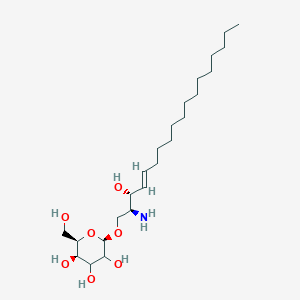
|
PSYCHOSINE |
PSYCHOSINE is a lipid of Sphingolipids (SP) class. Psychosine is associated with abnormalities such as Globoid cell leukodystrophy, Demyelinating Diseases, Multiple Sclerosis, nervous system disorder and Lysosomal Storage Diseases. The involved functions are known as Ionization, Pathogenesis, Demyelination, 5-(carboxyamino)imidazole ribonucleotide mutase activity and Increased Sensitivy. Psychosine often locates in Body tissue, CNS - Brain (MMHCC), Autosome, Peripheral Nervous System and Nerve Tissue. The associated genes with PSYCHOSINE are GALC gene, NTRK1 gene, JUN gene, ALPP gene and Polylysine. The related lipids are Fatty Acids, fatty aldehyde, lysophosphatidic acid, Stearic acid and stearoyl chloride. The related experimental models are Mouse Model and Streptozotocin Diabetes. |
281 |

|
cholesterol |
cholesterol is a lipid of Sterol Lipids (ST) class. Cholesterol is associated with abnormalities such as Trypanosomiasis, Chagas Disease, Cleft Palate, Chondrodysplasia punctata 2, X-linked dominant and Child syndrome. The involved functions are known as Blood Circulation, Sterol Biosynthesis Pathway, Receptor Mediated Endocytosis, Methylation and Signal. Cholesterol often locates in Animal tissue, Blood, Membrane, Plasma membrane and peroxisome. The associated genes with cholesterol are MBD2 gene, SIM, SLC33A1 gene, Genome and NSDHL gene. The related lipids are Sterols, zymosterol, fecosterol, Total cholesterol and 7-dehydrocholesterol. The related experimental models are Mouse Model, Knock-out, Genetically Engineered Mouse and Disease model. |
98461 |
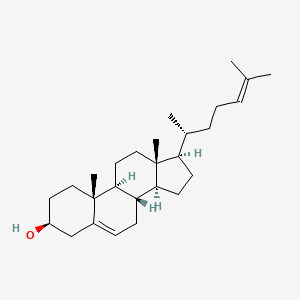
|
DESMOSTEROL |
DESMOSTEROL is a lipid of Sterol Lipids (ST) class. Desmosterol is associated with abnormalities such as Cataract, Congenital Abnormality, Liver diseases, Erectile dysfunction and Multiple congenital anomalies. The involved functions are known as Bulla, Methylation, cholesterol biosynthetic process, Process and cholesterol efflux. Desmosterol often locates in Body tissue, Tissue membrane, Plasma membrane, Pore and Endoplasmic Reticulum. The associated genes with DESMOSTEROL are P4HTM gene, SHH gene, WDR48 gene, CFLAR gene and SLC33A1 gene. The related lipids are Sterols, androstanol, Steroids, Unilamellar Vesicles and 7-dehydrocholesterol. The related experimental models are Transgenic Model and Rodent Model. |
251 |
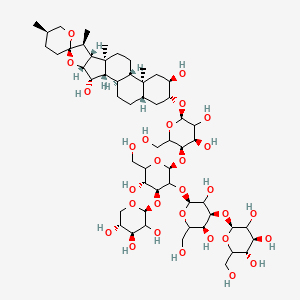
|
Digitonin |
Digitonin is a lipid of Sterol Lipids (ST) class. Digitonin is associated with abnormalities such as SCHOPF-SCHULZ-PASSARGE SYNDROME (disorder), Infection, BOSLEY-SALIH-ALORAINY SYNDROME, Hyperostosis, Diffuse Idiopathic Skeletal and FRONTOTEMPORAL DEMENTIA, CHROMOSOME 3-LINKED. The involved functions are known as Coprecipitation, establishment and maintenance of localization, Mutation, protein thiol-disulfide exchange and Receptor Binding. Digitonin often locates in Protoplasm, Cytoplasm, Membrane, Cytoplasmic matrix and Cytoplasmic Domain. The associated genes with Digitonin are Integral Membrane Proteins, Polypeptides, GOLPH3 gene, GAS1 gene and TRAF3IP2 gene. The related lipids are Promega, Sterols, 1,2-dihexadecyl-sn-glycero-3-phosphocholine, proteoliposomes and Lysophosphatidylcholines. |
2282 |









